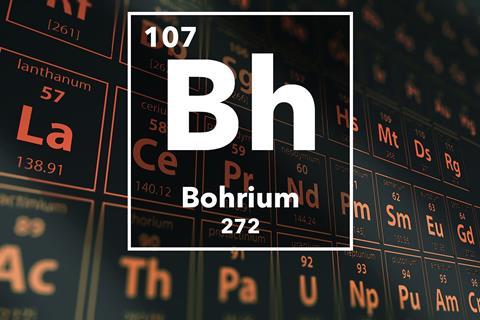Meera Senthilingam
This week we are fusing nuclei. Erric Scerri.
Eric Scerri
A total of 25 transuranium elements have now been artificially synthesised, starting with neptunium element 93 and ending with the as yet unnamed element 118. This includes the most recently announced element of all, element 117 that was synthesised in April 2010.
This podcast is about one of these elements, number 107 in the periodic table, called bohrium. Transuranium elements are essentially made by slamming atoms of different elements into each other at very high speeds in the hope that such collisions will allow nuclei to fuse together to form atoms of a new element.

The few atoms that ever form in this way are very unstable and typically decay with half-lives of seconds or fractions of a second. Lay persons often wonder why such experiments are important since practical applications of the elements that are man-made are generally out of the question. The answer is that the experiments are of scientific importance since they allow one to verify theoretical predictions. Element 107 has had a special role to play in this respect and I will return to this in a moment.
Bohrium is also special in another respect, as the first element to be synthesised by a cold – rather than hot – fusion process between two nuclei. The idea is to make two nuclei collide at low excitation energies and consequently to capitalise on the reduced tendency of such combined atoms to disintegrate. Incidentally, this kind of cold fusion has no connection to the alleged cold-fusion that was announced in 1989 by Martin Fleischmann and Stanley Pons who reported that they had produced fusion in a tabletop experiment using heavy water.
The successful cold fusion synthesis of bohrium was first achieved in 1981 in Darmstadt, Germany, by the fusion of bismuth-209 with chromium-24 to form bohrium-262 with a half life of about 85 milliseconds. Since then many other isotopes of bohrium have been produced, including the longest lived isotope so far bohrium-270, with a half life of 61 seconds.

The element's discoverers wanted to call it nielsbohrium after the great 20th century Danish physicist. But Iupac, the official body that governs the naming of elements, ruled against this name on the grounds that no element had ever been given the full name of a scientist. Instead they proposed bohrium, which became the officially recognised name in 1997.
In the periodic table bohrium lies below chromium, technetium and rhenium in group 6. However, the application of the theory of relativity to calculations involving very heavy atoms like bohrium leads to predictions of anomalous behaviour which suggests that they do not behave as typical members of the groups that they lie in. For example, the discovery of elements 104 and 105, rutherfordium and dubnium respectively, and chemical experiments conducted on them, strongly suggested that relativistic effects were causing these elements to behave in anomalous ways and not as expected according to their places in the periodic table. It began to look as if the periodic law, of which the periodic table is a graphic representation, had met its match.
It was only when the chemistry of elements 106 and 107, or seaborgium and bohrium respectively, were examined that it became clear that the periodic law was not being over-turned by relativistic effects. Quantitative experiments on the properties of the oxychloride of bohrium, in particular, showed that the element was behaving almost exactly that one would have predicted from its position below technetium and rhenium in the periodic table. In fact an article describing the chemistry of bohrium that appeared in the journal Nature with the title 'Boring bohrium', referring to the fact that bohrium was behaving as expected and not showing the exotic signs of relativistic effects.
It is quite remarkable that the periodic law that was discovered over 140 years ago has not been overturned by quantum mechanics or by the theory of relativity which date from more recent times and which one might suppose to have penetrated into the secrets of nature to a greater degree. Or perhaps it is just that the phenomenon of chemical periodicity as embodied by the periodic table represents a completely universal and fundamental principle of nature.
Meera Senthilingam
So the impressive accuracy of chemical periodicity. That was UCLA scientist and author Eric Scerri with the lawful chemistry of bohrium. Now next week we flash back to a memorable decade.
Anna Lewcock
Do you remember the 80s? The leg warmers, the big hair, the shoulder pads? Many fashion crimes were committed and statements made as a generation fought to carve out its identity.
Looking back on those photos a couple of decades down the line, some might wish they hadn't fought so hard. But it's not just rebellious teenagers or disillusioned 40-somethings that suffer identity crises – elements can too.
Meera Senthilingam
And to discover the crises that face the element hassium join the RSC's Anna Lewcock in next week's Chemistry in its element. Until then thank you for listening, I'm Meera Senthilingam.













No comments yet